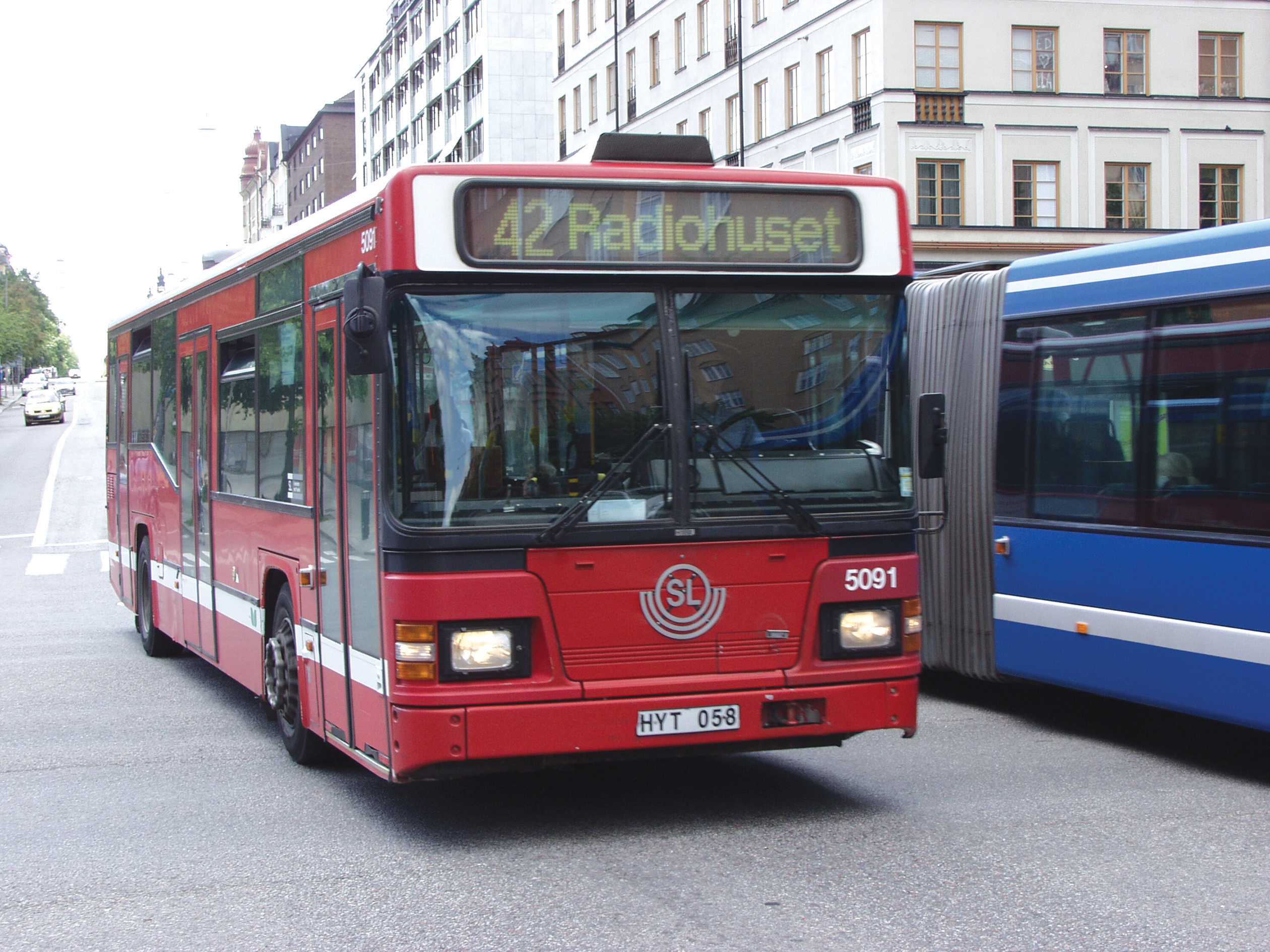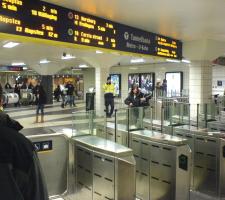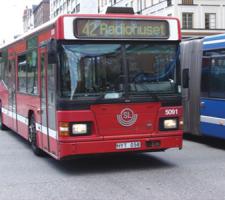
David Crawford looks forward to the completion of Stockholm's JustNu project
End-2010 is the target date for delivery of the final stages of Stockholm public transport authority (PTA)The core element in SL's concept is a common, multi-operator passenger information strategy, designed to give travellers using any transport mode current and relevant details about their whole journey "whenever they need it, wherever they are and via the channel that they prefer". The key issue for SL is that whether the traveller is looking at real-time passenger information displays, the internet or wayside timetables the details being given should always look the same, irrespective of who is providing the vehicle or transportation mode.
"The problem," says SL's JustNu Project Leader Mats Fornstedt, "is that providing a comprehensive service means that large amounts of data have to be transferred between a number of systems that vary in their ability to exchange and share it. Passengers, however, have the right to expect a similar quality of information throughout their journeys.
"The increasing demand for passenger information risks exposing gaps inherent in the way in which it is currently being dispersed." The issue is highlighted by the fact that the Swedish capital's public transport modes - bus, tram, metro and commuter rail - between them operate seven different Automated Vehicle Monitoring Systems (AVMS).
One solution to the problem of would have been to adopt a 'monolithic' approach, with a single provider delivering all the necessary ICT system components to all the operators and the authority. This would obviously have substantially reduced the integration issues.
On the other hand, operators would have lost the freedom to choose systems that best meet their individual needs on commercial and operational rounds. Again, the requirement for all Stockholm buses to carry the same equipment would have impacted on individual operators' abilities to switch vehicles flexibly between different regions.
Central integrator concept
Having researched the experience of other major Scandinavian PTAs, including those of the Danish capital, Copenhagen, and Gothenburg, Sweden's second-largest city, SL therefore rejected this approach. It went instead for the concept of a central integrator with open interfaces.The tender was won by Swedish transportation software specialist Hogia, in its first experience of working with SL. The company's offer was based on its Public Transport Division's PubTrans central system, introduced to meet Scandinavian requirements for supplier independence, the maintenance of historic investments and the ability to source the market for best-value new systems as needed.
Designed to optimise public transport operation and resource use by receiving, processing and distributing traffic, Automatic Vehicle Location (AVL) and passenger-oriented data between systems in real time, PubTrans automatically adapts information depending on the direction in which it is sent - for example, to drivers, control centres or passenger displays. Complementary components include the Deviation Manager System, developed to help a PTA handle service alterations and give travellers prompt information about them; and Timetable Output Manager, for the automated production of schedules.
As the PTA, SL will maintain the central integrator as the common platform. The structure is of a layer of services combining variously sourced travel data while clearly separating the task of providing information from that of presenting it.
This also allows operators the choice of a range of suppliers of presentation systems, with new providers capable of being added as they enter the market. But the information presented will always be of the same type, for ease of recognition and use. As Hogia Public Transport Systems Chief System Architect Ulf Bjersing points out: "Most people have attention spans of only a few seconds to understand any display."
European bus system of the future
Hogia are coordinators of the 'Multi-AVMS Coordination' task in work package (WP) 3.2 of the €26 million 2008-2012 European Bus System of the Future (EBSF) project. An initiative under the EU's Seventh Research and Development (FP7) project, led by .the International Association of Public Transport (UITP), this aims to develop, for transport operators, a system that will give bus operators more detailed information on their vehicles' and drivers' performance.
Hogia is taking on the role of integrator in the package, which will see German AVMS supplier Init exchanging information with French counterpart Ineo-Systrans, via PubTrans. The process will use respective versions of the Service Interface for Real Time Information (SIRI) European XML protocol.
"This," says Hanson, "will be a European-level demonstration of the capability of the concept of a central integrator with open interfaces for reducing the extent of integration as additional systems are added." The company sees the role as furthering its aim of establishing PubTrans outside Scandinavia.
From a European perspective, EBSF - currently the largest single EU-supported public transport project - aims to help development of an innovative high-quality bus operational system. In the commercial context, this aims to boost the international competitive position of the EU's bus industry under the 'European Bus System' brand.
The project is bringing together the pre-competitive R&D expertise of the five major European bus manufacturers (Evobus/Mercedes, Irisbus Iveco, MAN, Scania and Volvo). PTA partners include Västtraffik, which operates in Gothenburg.
Buses first
Implementation has started with buses, as being the largest vehicular component of the Stockholm public transport offer - and to highlight SL's policy of meeting public expectations of a frequent, reliable and easy-to-understand service. The system is currently in use by over 2,000 Stockholm vehicles reporting in real time, with others continuing to be linked in.The final year of the project is focusing on the integration of Stockholm's commuter rail and metro routes to expand the service across the entire public transport network, ensure scope for bringing in future third-party information transport providers, and influencing public attitudes to SL. It is also addressing the need to provide more useful information on interruptions to services.
The importance of this has been highlighted in an August 2009 onboard survey of passenger perceptions of travel information in the Swedish capital. The results showed that, while between 70 and 80 per cent of respondents were satisfied with the quality of real-time information so far being provided by SL 50 per cent were dissatisfied with the available levels of disruption information.
This arose from the fact that service control systems, used to implement operational decisions by SL or a transport provider, such as temporary stop closures or a change of route or destination, are not typically designed with the information needs of prospective passengers in mind. Inadequacy here, SL concluded, was having the greatest single negative impact on passenger satisfaction.
"In essence", says Fornstedt, "passengers appreciated SL's real-time information. But, when they most needed relevant up-to-dating, they could not find it."
Says Hogia's Jonatan Hanson: "We are coming from the real-time information perspective, and not that of schedule planning."
SL will therefore be equipped to use the central platform to capture these decisions as they are entered into control systems. This will then automatically relay them in a uniform format to an open, standardised interface, for access by any passenger information system.
Information availability
JustNu information is available on the Internet, via journey planners and subscription traffic information services distributed by email or mobile phones. Over time, the system will also be available for use by external agencies such as the police or fire department to report incidents that are likely to affect public transport.SL, a limited company owned by the Greater Stockholm Regional Council, is responsible for over half of all public transport journeys made in Sweden. Each working day, it carries over 700,000 passengers on more than 2.44 million journeys, logs 100,000 visitors to the SL website, and answers 230,000 questions a day put to its journey planner.
External factors driving the case for a more efficient public transport information service include the fact the population of the Stockholm Region is predicted to rise by 21,000 per year until 2020, as planned new housing development areas reach completion. At the same time, new restrictions on road traffic, environmental regulations and the rising cost of driving are all likely to predispose travellers towards using public transport if it offers an attractive alternative.
| Mode | Lines/routes | Passengers '000 | % total passenger volume |
|---|---|---|---|
| Commuter rail | 3 | 250 | 10 |
| Light rail | 8 | 125 | 5 |
| Metro | 7 | 1117 | 45 |
| Bus | 472 | 989 | 40 |
| Two service scheduling systems |
| Seven real-time passenger information systems for bus, metro, tram and rail |
| Three display systems |
| A journey planner |
| Timetable printing system |
| Timetable information on SL home page |
| Real-time passenger information on SL homepage and mobiles |
| Service deviation information on SL homepage and mobiles |
| Voice announcements on platforms |













